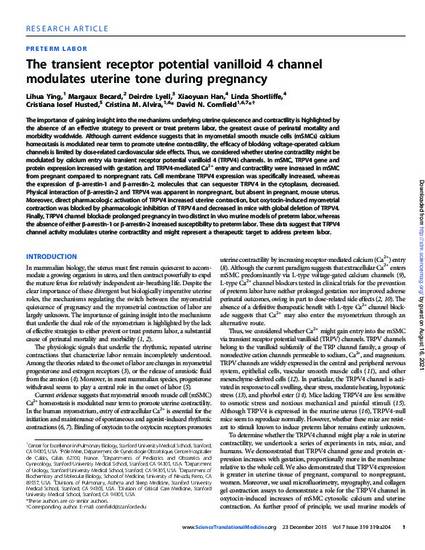
The importance of gaining insight into the mechanisms underlying uterine quiescence and contractility is highlighted by the absence of an effective strategy to prevent or treat preterm labor, the greatest cause of perinatal mortality and morbidity worldwide. Although current evidence suggests that in myometrial smooth muscle cells (mSMCs) calcium homeostasis is modulated near term to promote uterine contractility, the efficacy of blocking voltage-operated calcium channels is limited by dose-related cardiovascular side effects. Thus, we considered whether uterine contractility might be modulated by calcium entry via transient receptor potential vanilloid 4 (TRPV4) channels. In mSMC, TRPV4 gene and protein expression increased with gestation, and TRPV4-mediated Ca2+ entry and contractility were increased in mSMC from pregnant compared to nonpregnant rats. Cell membrane TRPV4 expression was specifically increased, whereas the expression of β-arrestin-1 and β-arrestin-2, molecules that can sequester TRPV4 in the cytoplasm, decreased. Physical interaction of β-arrestin-2 and TRPV4 was apparent in nonpregnant, but absent in pregnant, mouse uterus. Moreover, direct pharmacologic activation of TRPV4 increased uterine contraction, but oxytocin-induced myometrial contraction was blocked by pharmacologic inhibition of TRPV4 and decreased in mice with global deletion of TRPV4. Finally, TRPV4 channel blockade prolonged pregnancy in two distinct in vivomurinemodels of preterm labor, whereas the absence of either β-arrestin-1 or β-arrestin-2 increased susceptibility to preterm labor. These data suggest that TRPV4 channel activity modulates uterine contractility and might represent a therapeutic target to address preterm labor.
Available at: http://works.bepress.com/xiaoyuan-han/52/
